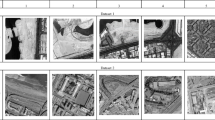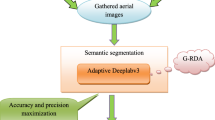Abstract
Aerial imagesemantic segmentation is crucial for various operations such as military observation, land classification, and disaster impact assessments involving unmanned aerial vehicles. Although existing system is unsuited for aerial applications, these algorithms are mostly trained on human-centric datasets like “Cityscapes and Cam Vid”. High-resolution aerial image semantic segmentation is a basic and difficult task with several applications. Even though numerous Convolution Neural Network (CNN) segmentation techniques have shown impressive results, it is still challenging to discriminate semantic parts among regions with comparable spectral properties employing only high-resolution data. Additionally, the typical data-independent up-sampling techniques could produce poor outcomes. Thus, a novel semantic segmentation technique is introduced to resolve the complication presented in the classical segmentation framework in aerial images by utilizing deep learning techniques. Here, an Adaptive and Attentive based TransDeeplabv3 + (AA-TransDeeplabv3 +)-based semantic segmentation model for input images is designed with a novel Hybridized Fire Hawk with Electric Fish Optimization (HFH-EFO). The parameters of Attentive-based TransDeeplabv3 + are tuned by developed HFH-EFO to attain the multi-objective function. The model is implemented using Python, which generates the empirical results. Therefore, the developed method achieves a dice coefficient of 93.02% and an accuracy value of 93.01%, outperforming traditionalapproaches. Hence, the proposedframework secures anexcellent result than the classical technique based on experimental analysis.















Similar content being viewed by others
Data Availability
No datasets were generated or analysed during the current study. In case of benchmark data: The data underlying this article are available in Semantic segmentation of aerial imagery “https://www.kaggle.com/datasets/humansintheloop/semantic-segmentation-of-aerial-imagery?select=Semantic+segmentation+dataset”. Aerial image segmentation dataset http://jiangyeyuan.com/ASD/Aerial%20Image%20Segmentation%20Dataset.html
References
Wang, S., Hou, X., Zhao, X.: Automatic building extraction from high-resolution aerial imagery via fully convolutional encoder–decoder network with non-local block. IEEE Access 8, 7313–7322 (2020)
Xiang, D., Zhang, X., Wu, W., Liu, H.: DensePPMUNet-a: a robust deep learning network for segmenting water bodies from aerial images. IEEE Trans. Geosci. Remote Sens. 61, 1–11 (2023)
Hou, J., Guo, Z., Feng, Y., Wu, Y., Diao, W.: SPANet: spatial adaptive convolution based content-aware network for aerial image semantic segmentation. IEEE J. Selected Topics Appl. Earth Observ. Remote Sens. 16, 2192–2204 (2023)
Niu, R., Sun, X., Tian, Y., Diao, W., Chen, K., Fu, K.: Hybrid multiple attention network for semantic segmentation in aerial images. IEEE Trans. Geosci. Remote Sens. 60, 1–18 (2022)
Tu, J., Sui, H., Feng, W., Sun, K., Hua, L.: Detection of damaged rooftop areas from high-resolution aerial images based on visual bag-of-words model. IEEE Geosci. Remote Sens. Lett. 13(12), 1817–1821 (2016)
Byeongjun, Y., Jeon, H., Bang, H., Yi, S.S., Min, J.: Fender segmentation in unmanned aerial vehicle images based on densely connected receptive field block. Int. J. Naval Archit. Ocean Eng. 14, 100472 (2022)
Chen, G., Hao, K., Wang, B., Li, Z., Zhao, X.: A power line segmentation model in aerial images based on an efficient multibranch concatenation network. Exp. Syst. Appl. 120359 (2023)
Dutta, K., Talukdar, D., Bora, S.S.: "Segmentation of unhealthy leaves in cruciferous crops for early disease detection using vegetative indices and Otsu thresholding of aerial images. Measurement 189, 110478 (2022)
Wang, Y., Wang, L., Huchuan, L., He, Y.: Segmentation based rotated bounding boxes prediction and image synthesizing for object detection of high resolution aerial images. Neurocomputing 388, 202–211 (2020). https://doi.org/10.1016/j.neucom.2020.01.039
Chai, D., Newsam, S., Huang, J.: Aerial image semantic segmentation using DCNN predicted distance maps. ISPRS J. Photogramm. Remote Sens. 161, 309–322 (2020)
Weng, Q., Chen, H., Chen, H., Guo, W., Mao, Z.: A multisensor data fusion model for semantic segmentation in aerial images. IEEE Geosci. Remote Sens. Lett. 19, 1–5 (2022)
Zhao, Y., Guo, P., Gao, H., Chen, X.: Depth-assisted ResiDualGAN for cross-domain aerial images semantic segmentation. IEEE Geosci. Remote Sens. Lett. 20, 1–5 (2023)
Sani-Mohammed, A., Yao, W., Heurich, M.: Instance segmentation of standing dead trees in dense forest from aerial imagery using deep learning. ISPRS Open J. Photogramm. Remote Sens. 6, 100024 (2022)
Zhou, T., Guo, J., Qilong, Wu., Chuan, Xu.: An unmanned aerial vehicle identification and tracking system based on weakly supervised semantic segmentation technology. Phys. Commun. 54, 101758 (2022)
Yang, L., Fan, J., Huo, B., Li, E., Liu, Y.: PLE-Net: Automatic power line extraction method using deep learning from aerial images. Exp. Syst. Appl. 198, 116771 (2022)
Park, J., Cho, Y.K., Kim, S.: Deep learning-based UAV image segmentation and inpainting for generating vehicle-free ortho mosaic. Int. J. Appl. Earth Obs. Geoinf. 115, 103111 (2022)
Dhami, H.S., Ignatyev, D., Tsourdos, A.: Semantic segmentation based mapping systems for the safe and precise landing of flying vehicles. IFAC-PapersOnLine 55(22), 310–315 (2022). https://doi.org/10.1016/j.ifacol.2023.03.052
Ahmed, S., Biswas, A.: A cross entropy and whale optimization algorithm based image segmentation for aerial images. Int. J. Inf. Technol. (2024). https://doi.org/10.1007/s41870-024-01831-z
Kapoor, S., Zeya, I.: Chirag Singhal and Satyasai Jagannath Nanda, “a grey wolf optimizer based automatic clustering algorithm for satellite image segmentation.” Proc. Comput. Sci. 115, 415–422 (2017)
Jia, H., Lang, C., Oliva, D., Song, W., Peng, X.: Hybrid grasshopper optimization algorithm and differential evolution for multilevel satellite image segmentation. Remote Sens. 11(9), 1134 (2019). https://doi.org/10.3390/rs11091134
Volpi, M., Tuia, D.: Deep multi-task learning for a geographically-regularized semantic segmentation of aerial images. ISPRS J. Photogramm. Remote Sens. 144, 48–60 (2018)
Behera, T.K., Bakshi, S., Sa, P.K.: A lightweight deep learning architecture for vegetation segmentation using UAV-captured aerial images. Sustain. Comput.: Inf. Syst. 37, 100841 (2023)
Gupta, A., Watson, S., Yin, H.: Deep learning-based aerial image segmentation with open data for disaster impact assessment. Neurocomputing 439, 22–33 (2021). https://doi.org/10.1016/j.neucom.2020.02.139
Gevaert, C.M., Belgiu, M.: Assessing the generalization capability of deep learning networks for aerial image classification using landscape metrics. Int. J. Appl. Earth Obs. Geoinf. 114, 103054 (2022)
Wieland, M., Martinis, S., Kiefl, R., Gstaiger, V.: Semantic segmentation of water bodies in very high-resolution satellite and aerial images. Remote Sens. Environ. 287, 113452 (2023)
Behera, T.K., Bakshi, S., Nappi, M., Sa, P.K.: Superpixel-based multiscale cnn approach toward multiclass object segmentation from UAV-captured aerial images. IEEE J. Selected Topics Appl. Earth Observ. Remote Sens. 16, 1771–1784 (2023). https://doi.org/10.1109/JSTARS.2023.3239119
Li, Bo., Chen, C., Dong, S., Qiao, J.: Transmission line detection in aerial images: An instance segmentation approach based on multitask neural networks. Signal Process.: Image Commun. 96, 116278 (2021)
Zhang, Y., Gao, X., Duan, Q., Yuan, L., Gao, X.: DHT: deformable hybrid transformer for aerial image segmentation. IEEE Geosci. Remote Sens. Letters 19, 1–5 (2022)
Jaimes, B.R.A., Ferreira, J.P.K., Castro, C.L.: Unsupervised semantic segmentation of aerial images with application to UAV localization. IEEE Geosci. Remote Sens. Lett. 19, 1–5 (2022). https://doi.org/10.1109/LGRS.2021.3113878
Abdelfattah, R., Wang, X., Wang, S.: PLGAN: generative adversarial networks for power-line segmentation in aerial images. IEEE Trans. Image Process. 32, 6248–6259 (2023)
Haoyu Yue, Junhong Yue, Xuejun Guo, Yizhen Wang and Liancheng Jiang, "MA-DBFAN: multiple-attention-based dual branch feature aggregation network for aerial image semantic segmentation", Signal, Image and Video Processing, (2024)
Li, Z., Wang, H., Liu, Y.: Semantic segmentation of remote sensing image based on bilateral branch network. Vis. Comput. 40, 3069–3090 (2024)
Mogaka, O.M., Zewail, R., Inoue, K., Sayed, M.S.: TinyEmergencyNet: a hardware-friendly ultra-lightweight deep learning model for aerial scene image classification. J. Real-Time Image Process. (2024). https://doi.org/10.1007/s11554-024-01430-y
Chen, H., Qin, Y., Liu, X., Wang, H., Zhao, J.: An improved DeepLabv3+ lightweight network for remote-sensing image semantic segmentation. Complex Intell. Syst. 10, 2839–2849 (2024)
Azizi, M., Talatahari, S., Gandomi, A.H.: Fire Hawk Optimizer: a novel metaheuristic algorithm. Artif. Intell. Rev. 56(1), 287–363 (2022). https://doi.org/10.1007/s10462-022-10173-w
Yilmaz, S., Sen, S.: Electric fish optimization: a new heuristic algorithm inspired by electrolocation. Neural Comput. Appl. 32, 11543–11578 (2020)
Tuli, S., Casale, G., Jennings, N.R.: TranAD: deep transformer networks for anomaly detection in multivariate time series data. Proc. VLDB Endowment 15(6), 1201–1214 (2022). https://doi.org/10.14778/3514061.3514067
Maitreya Suin, Kuldeep Purohit, A. N. Rajagopalan, "Spatially-Attentive Patch-Hierarchical Network for Adaptive Motion Deblurring," computer vision foundation, pp. 3606, (2020)
Xie, L., Han, T., Zhou, H., Zhang, Z.-R., Han, B., Tang, A.: Tuna swarm optimization: a novel swarm‐based metaheuristic algorithm for global optimization. Comput. Intell. Neurosci. (2021). https://doi.org/10.1155/2021/9210050
Wang, Z.W., Wang, H., Yildizbasi, A.: Developed coyote optimization algorithm and its application to optimal parameters estimation of PEMFC model. Energy Rep. 6, 1106–1117 (2020)
Zeng, H., Peng, S., Li, D.: Deeplabv3+ semantic segmentation model based on feature cross attention mechanism. J. Phys. Conf. Ser. 1678, 012106 (2020)
Acknowledgements
I would like to express my very great appreciation to the co-authors of this manuscript for their valuable and constructive suggestions during the planning and development of this research work.
Funding
This research did not receive any specific funding.
Author information
Authors and Affiliations
Contributions
All authors have made substantial contributions to conception and design, revising the manuscript, and the final approval of the version to be published. Also, all authors agreed to be accountable for all aspects of the work in ensuring that questions related to the accuracy or integrity of any part of the work are appropriately investigated and resolved.
Corresponding author
Ethics declarations
Conflict of interest
The authors declare no competing interests.
Ethical approval
Not Applicable.
Informed consent
Not Applicable.
Additional information
Publisher's Note
Springer Nature remains neutral with regard to jurisdictional claims in published maps and institutional affiliations.
Rights and permissions
Springer Nature or its licensor (e.g. a society or other partner) holds exclusive rights to this article under a publishing agreement with the author(s) or other rightsholder(s); author self-archiving of the accepted manuscript version of this article is solely governed by the terms of such publishing agreement and applicable law.
About this article
Cite this article
Anilkumar, P., Venugopal, P., Lokesh, K. et al. AA-TransDeeplabv3 + : a novel semantic segmentation framework for aerial images using adaptive and attentive based Transdeeplabv3 + with hybrid optimization technique. SIViP 19, 225 (2025). https://doi.org/10.1007/s11760-024-03617-z
Received:
Revised:
Accepted:
Published:
DOI: https://doi.org/10.1007/s11760-024-03617-z




